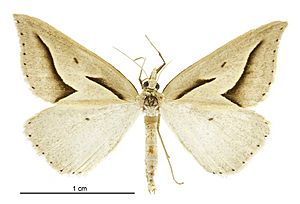Samana acutata facts for kids
Quick facts for kids Samana acutata |
|
|---|---|
 |
|
| Male | |
| Scientific classification | |
| Kingdom: | |
| Phylum: | |
| Class: | |
| Order: | |
| Family: | |
| Genus: |
Samana
|
| Species: |
S. acutata
|
| Binomial name | |
| Samana acutata Butler, 1877
|
|
The Samana acutata is a type of moth that belongs to the Geometridae family. This special moth lives only in New Zealand. It is currently listed as "At Risk, Relict" by the Department of Conservation, meaning it needs help to survive.
Contents
About This Moth
This moth was first described in 1877 by a scientist named Arthur Gardiner Butler. He studied a moth collected from Christchurch in the South Island. Later, another scientist, George Hudson, wrote about and drew this moth in his books about New Zealand's butterflies and moths. The original moth specimen used for its description is kept safe at the Natural History Museum, London.
What Does It Look Like?
The Samana acutata moth has pale straw-yellow front wings. It has a small dark spot and a zigzag line on these wings. Along the edge of its wings, there are small black dots. Its back wings are white with creamy edges and also have black dots. The moth's body is pale yellow on top and white underneath. Its wings can spread about 1 inch and 2 lines wide (about 3 cm).
Where Does It Live?
This moth is found only in New Zealand. You can find S. acutata in areas like Mid Canterbury and Central Otago. Sadly, it no longer lives in the place where it was first discovered.
Life Cycle and Behavior
The young moths, called larvae, have been seen in January and March. The adult moths fly around in September and October. Scientists have noticed that these moths are attracted to light, especially at night.
What It Eats and Where It Lives
The Samana acutata moth larvae eat native New Zealand broom plants from the Carmichaelia group. This includes plants like Carmichaelia australis and Carmichaelia appressa. These moths like to live in dune ecosystems, which are sandy areas near the coast. They have also been found in places with plants like gorse and mānuka.
Why Is It At Risk?
This moth is classified as "At Risk, Relict" under the New Zealand Threat Classification System. This means it is in danger because its home is changing. Its food plants are disappearing due to farming and new buildings. Also, new plants like sea spurge are invading its habitat, which makes it harder for the moth to find its food and survive.
Images for kids


